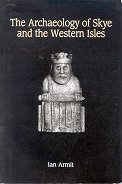The Sculptor’s Cave takes its name from Pictish symbols carved around
its distinctive twin entrance passages.
The first excavations, in the 1920s, yielded disarticulated human bones
alongside rich objects from the Late Bronze Age and Roman Iron Age,
but the methods of the time precluded any real understanding of activity inside the cave.
Renewed excavations in the 1970s revealed
complex stratigraphic and palaeoenvironmental data,
but the work remained unpublished.
New analysis, including a major programme of radiocarbon dating,
shows that activity began during the Late Bronze Age,
when the bodies of children were brought to the cave,
seemingly as mummy bundles adorned with gold and bronze jewellery.
Complex timber structures, hearths and cooking debris
attest to sustained activity until the Roman Iron Age,
when people once again came to lay out their dead.
At some point in the third or fourth centuries AD,
the cave also became the imposing ritual backdrop for
the systematic beheading of several people.
Finally, with the creation of the carvings, the cave passed into myth and memory.
